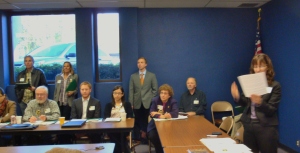Audubon @Home, Arizona
by Krys Hammers
President
Desert Rivers Audubon Society
 We have become so dependent on our cars in the Phoenix area, as in most US cities. Yet this overuse of fossil fuels pollutes our air, threatens the Arctic National Wildlife Refuge and other drilling sites, and keeps us dependent on foreign oil-producing countries. Still our cars offer us the freedom to come and go as we please. How can we reconcile negative impacts of our use of fossil fuels with our freedom? Here are a few suggestions to become more fuel-efficient.
We have become so dependent on our cars in the Phoenix area, as in most US cities. Yet this overuse of fossil fuels pollutes our air, threatens the Arctic National Wildlife Refuge and other drilling sites, and keeps us dependent on foreign oil-producing countries. Still our cars offer us the freedom to come and go as we please. How can we reconcile negative impacts of our use of fossil fuels with our freedom? Here are a few suggestions to become more fuel-efficient.
Hybrid cars may not be the best fit for everyone, but we can support the technology with our pocketbooks by investing in a hybrid. I think it is the technology of the future, but it needs to continue to be refined. Additionally, the more we support the technology, the more widespread and the cheaper these cars will become. Smart Cars or even smaller cars are also a good choice. If you drive 15,000 miles a year, the difference between getting 30 MPG and 20 MPG at $3.50 per gallon of gas will equate to $875.
Most of us spend many hours in traffic during our commute to work each week. Try carpooling. Not only will you save half of your fuel bill and wear and tear on your car, but also you’ll have someone to talk to during those lost hours. You’ll be able to use the HOV lane and some companies provide preferential parking for carpoolers. Even 2 or 3 days a week will result in a great savings. Ask your employer to start a carpool program if they don’t already have one. Maybe they can team you with someone who lives near you and shares your schedule.
The biggest drain on gas mileage is starting and stopping. Avoid the jackrabbit starts and racing up to stop lights. According to EarthEasy.com, “In city driving, nearly 50% of the energy needed to power your car goes to acceleration.“ This was a hard concept for me to wrap my mind around. I’ve always had an Indy 500 mentality. I always wanted to be the first one off the line and the guy in front of me was always going too slowly. I now have a car that shows fuel consumption in real time and I can see how high that gauge goes when I engage in that behavior. Now when I see a red light up ahead I take my foot off the accelerator and start coasting, hoping that the light will turn and I won’t have to stop at all.
Keep your car in good shape. Changing your Air Filters regularly can result in a 10%  savings in fuel economy. One of the most important things is keeping your tires properly inflated. If your tires are under-inflated, it can cost you up to 6% more in fuel. The pressure printed on the side of your tire is the Maximum operating pressure and not necessarily the optimum tire pressure. Check your owner’s manual for the optimum pressure. You can get a good, easy-to-use digital tire pressure gauge at any auto parts store. Regularly check your tires before you drive your car.
savings in fuel economy. One of the most important things is keeping your tires properly inflated. If your tires are under-inflated, it can cost you up to 6% more in fuel. The pressure printed on the side of your tire is the Maximum operating pressure and not necessarily the optimum tire pressure. Check your owner’s manual for the optimum pressure. You can get a good, easy-to-use digital tire pressure gauge at any auto parts store. Regularly check your tires before you drive your car.
You have to find the right balance for yourself. You can check for more simple tips to reduce your fuel consumption at www.fueleconomy.gov. Please drive safely and efficiently.








